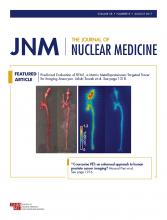TO THE EDITOR: With interest we read the article by Kaste et al. (1) entitled “Comparison of 11C-Methionine and 18F-FDG PET/CT for Staging and Follow-up of Pediatric Lymphoma” that was recently published in The Journal of Nuclear Medicine. Kaste et al. mention 18F-FDG PET to be a valuable tool for staging and response monitoring in lymphoma, with a particularly high sensitivity but limited specificity due to nonmalignant etiologies that may mimic tumor uptake. Therefore, another tracer, 11C-methionine, was investigated and compared with 18F-FDG for both staging and monitoring response to therapy in 21 pediatric patients (19 with Hodgkin lymphoma and 2 with diffuse large B-cell lymphoma). At staging, 3 nodal groups demonstrated discordant metabolic activity, whereas all others had concordant metabolic activity. Eight weeks after treatment, paired 18F-FDG and 11C-methionine PET images were available for 15 patients, of whom 14 (93.3%) had concordant 18F-FDG PET and 11C-methionine PET results. In the remaining patient, metabolic activity was minimally discordant: 18F-FDG PET had normalized, but the 11C-methionine PET study remained slightly positive. This particular patient remained well for more than 3 y from diagnosis without further treatment (i.e., false-positive results on end-of-treatment 11C-methionine PET). During follow-up, 3 patients developed disease relapse and 1 patient developed a secondary diffuse large B-cell lymphoma (importantly, it was not reported how these events related to the end-of-treatment 18F-FDG and 11C-methionine PET results), and no deaths occurred. Kaste et al. concluded 11C-methionine uptake to be elevated in most lymphomatous regions, both at baseline and at the end of treatment.
However, we disagree with Kaste et al.'s (1) conclusion. Their claim that increased 11C-MET uptake is observed in most regions involved with lymphoma cannot be determined by a comparison with staging and response assessment 18F-FDG PET scans, due to a suboptimal sensitivity and specificity of this imaging modality. First, 18F-FDG can accumulate in many other types of cancer and in several benign alterations, particularly infections (and treatment-induced inflammatory changes), as already noted by Kaste et al. themselves. Studies have also shown that tumor-associated 18F-FDG uptake is due not only to viable tumor cells but also to a considerable proportion of nonneoplastic cellular elements (such as macrophages) (2). Hodgkin lymphoma, in particular, is an extreme example of this phenomenon, since malignant Reed–Sternberg tumor cells occupy only 0.1%–1.0% of the pathologic substrate, with the remainder consisting of inflammatory cells. In addition, after the start of chemotherapy, an increase in the apoptotic and necrotic tumor fraction is followed by an early (4–6 d afterward) influx of inflammatory cells that consume 18F-FDG (3). Therefore, 18F-FDG avidity during or after treatment generally does not reflect lymphomatous tissue, as has already been demonstrated by several studies that showed a high rate of biopsied false-positive 18F-FDG–avid residual lesions (4). On the other hand, negative 18F-FDG PET results cannot exclude lymphomatous tumor involvement, particularly after treatment. This has been convincingly shown by several studies reporting absence of 18F-FDG–avid bone marrow lesions in patients with lymphoma-positive bone marrow biopsies (5). Furthermore, antilymphoma therapy has been reported to reduce glucose uptake by malignant cells as a result of downregulation of glucose membrane transporters or hexokinase activity (6), generating false-negative results. Finally and most importantly, because the spatial resolution of current PET systems is only 6–7 mm, involvement by small lymphomatous deposits cannot be excluded (7). This hypothesis is supported by findings such as the occurrence of disease relapse in many patients who acquired a 18F-FDG PET–negative status (8,9), the lower relapse rate in patients with negative 18F-FDG PET results after chemotherapy plus radiation therapy than after chemotherapy alone (10), and the huge proportions of patients with incurable, indolent lymphomas who acquire a negative 18F-FDG PET status after noncurative chemotherapy. However, this last finding by no means implies the absence of residual lymphomatous disease after treatment.
In conclusion, caution is warranted when using staging and (particularly) response-assessment 18F-FDG PET scans as a reference standard for determining the presence or absence of lymphoma deposits throughout the body, since this test suffers from a nonnegligible proportion of false-positive and false-negative results. Because Kaste et al. reported 11C-methionine PET results to closely match 18F-FDG PET results, they should have concluded that the former appears to be as good as, or as bad as, the latter in terms of lymphoma detection, rather than that 11C-methionine uptake is elevated in most lymphomatous regions.
Footnotes
Published online Dec. 1, 2016.
- © 2017 by the Society of Nuclear Medicine and Molecular Imaging.







